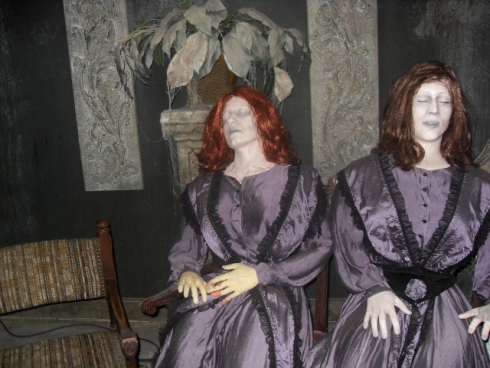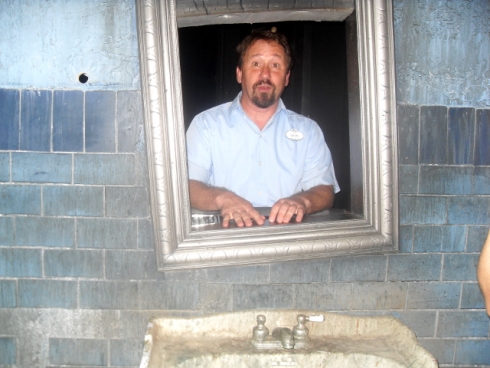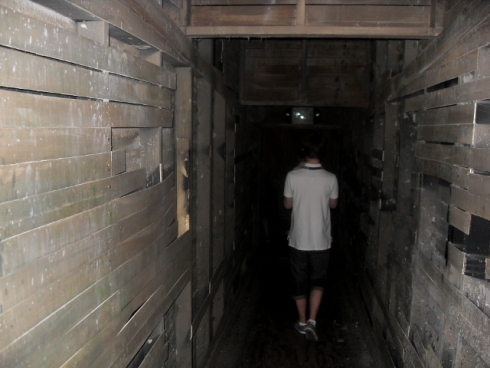
Universal Orlando’s Halloween Horror Nights has evolved from a 3-night party to an elaborate 28-night spectacle. While every department plays an important role, from marketing to security, each year’s event is designed and created by a surprisingly small Art & Design team.
Haunt industry experts who also happen to be HHN super-fans, the A & D team bends over backwards to thrill long-time aficionados and brand new visitors alike. One of the secrets to their success is the subtle use of psychology to build the scares.
Let's take a look at six of their most successful tactics...
1. Diversion
 Mannequins DiversionThese mannequins are a great diversion from the scareactors nearby.
Mannequins DiversionThese mannequins are a great diversion from the scareactors nearby.
Legendary horror filmmaker Alfred Hitchcock was known for his twist endings. He was a master at leading his audiences down a path of expectations and then taking a sharp and completely unexpected turn. Yet in retrospect, the twist ending was foreshadowed from the beginning. This tactic works because our brains tend to fill in the gaps in the information that is presented and create scenarios that make sense to us. The diversion is the set-up for a good scare.
Halloween Horror Nights is packed with diversions. A mannequin sitting motionless in a chair is spotlighted to catch your eye, ensuring that you never notice the killer clown skulking in the darkness. A loud noise makes you run forward, straight into a room filled with zombies. Like Hitchcock himself, the A & D team is excellent at leading you down one path of expectations before sending you hurtling into an entirely different layer of fear.
2. Surprise
 Sliding MirrorAs demonstrated by our tour guide, this mirror slides back to reveal a scareactor.
Sliding MirrorAs demonstrated by our tour guide, this mirror slides back to reveal a scareactor.
The other half of Hitchcock’s twist ending is the element of surprise. Since your brain has already filled in the details based on the diversion, you are primed for an unexpected startle. Arguably the most famous twist ending of all was Hitchcock’s masterpiece, Psycho. Think back to the moment you saw the corpse of Norman Bates’ mother. Those few seconds of film are enshrined in movie history due to the shock they induced in audiences.
HHN is packed with surprises designed to startle unsuspecting visitors. A mirror turns out to be a sliding door with a scareactor behind it. You stop to take photos of the marching Chainsaw Drill Team, only to be shocked when the Drill Team breaks ranks and scatters through the crowd, chainsaws screaming in the night. You come around a corner heading for the bathroom, when a very large actor wielding an even larger spear suddenly hisses in your ear.
3. Pacing
 Foreboding HallwayThis foreboding hallway helps to pace your experience in the haunted house.
Foreboding HallwayThis foreboding hallway helps to pace your experience in the haunted house.
Have you ever been to a local haunt that just throws scare after scare after scare in your direction? At the beginning, you might scream and run. By halfway through the house, your reflexes have dulled. You might still jump a bit, but everything seems to run together. It gets boring, and you’re ready to just take a nap.
There are a couple of different psychological principles at work here. One is the nature of the fear response. When you are frightened, your sympathetic nervous system takes over and induces what is known as fight or flight. The primitive parts of your brain want to fight the threat or run away—always choose flight, as fighting will get you in trouble! After a while, though, the parasympathetic nervous system takes over. Your brain realizes you aren’t really going to die, your body relaxes, your heart rate returns to normal and you start feeling a little foolish. You also get tired due to the extra energy you expended being afraid.
If you are a very fearful person, your parasympathetic nervous system might not take over while you’re still in the haunted house. Instead, you might slip into what is known as learned helplessness. Investigated in a famous series of experiments with dogs given electrical shocks, learned helplessness sets in when you begin to feel that there is no escape. Your sympathetic nervous system sort of gives up, and finishing the haunt just feels like a test of endurance.
The A & D team expertly avoids these responses by incorporating pacing techniques, both within each individual haunt and throughout the event itself. Within each house and scare zone are dead sets—places that are highly decorated but contain no scareactors or audio-animatronics. These spots allow your heart rate, breathing and other physical reactions to calm down, while building anticipation for what might come at you next. These carefully crafted pauses keep the tension at a slow build and keep you engaged in the experience.
The overall event is known for its haunted houses and street scares, but it also features at least two live stage shows each year. Many of the rides, shops and restaurants are open as well. Much like the dead sets, taking in a funny show or a favorite ride allows you to take a break from the scares. You can reset your own emotional responses and then revisit the scariest elements when you are ready.
Add new comment